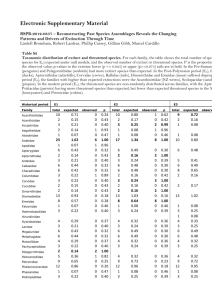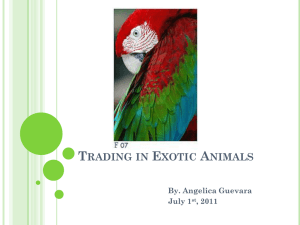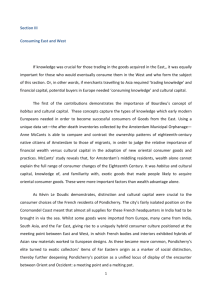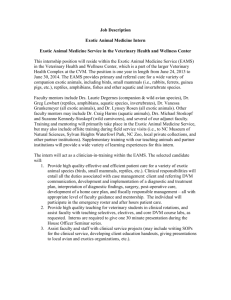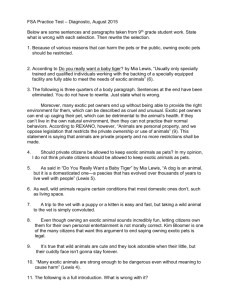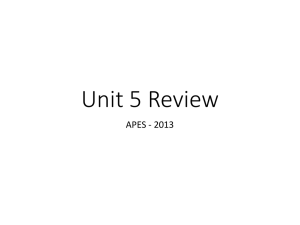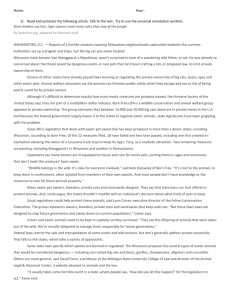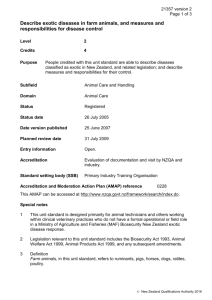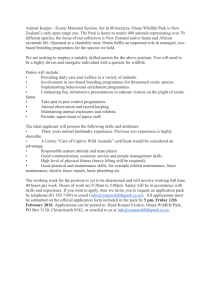Why do alien species can succeed at establishing themselves in
advertisement
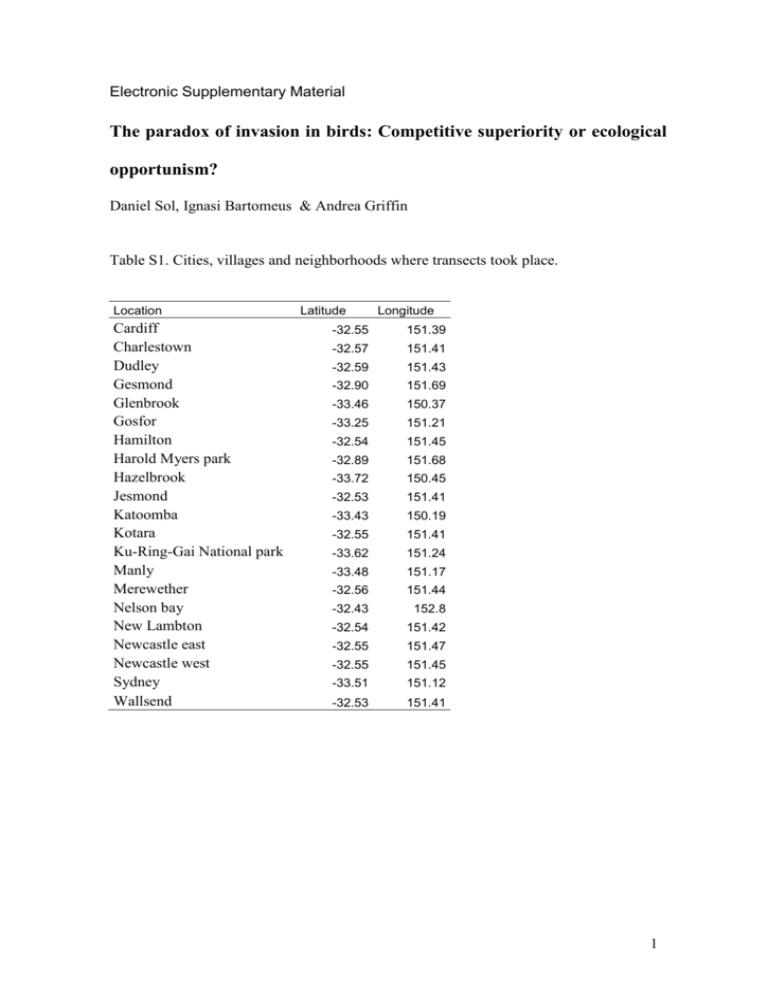
Electronic Supplementary Material The paradox of invasion in birds: Competitive superiority or ecological opportunism? Daniel Sol, Ignasi Bartomeus & Andrea Griffin Table S1. Cities, villages and neighborhoods where transects took place. Location Cardiff Charlestown Dudley Gesmond Glenbrook Gosfor Hamilton Harold Myers park Hazelbrook Jesmond Katoomba Kotara Ku-Ring-Gai National park Manly Merewether Nelson bay New Lambton Newcastle east Newcastle west Sydney Wallsend Latitude Longitude -32.55 151.39 -32.57 151.41 -32.59 151.43 -32.90 151.69 -33.46 150.37 -33.25 151.21 -32.54 151.45 -32.89 151.68 -33.72 150.45 -32.53 151.41 -33.43 150.19 -32.55 151.41 -33.62 151.24 -33.48 151.17 -32.56 151.44 -32.43 152.8 -32.54 151.42 -32.55 151.47 -32.55 151.45 -33.51 151.12 -32.53 151.41 1 Table S2. Abundance (total number of individuals observed) of each species recorded during the transects in the three habitats studied. Family Anatidae Accipitridae Ardeidae Charadriidae Falconidae Laridae Pelecanidae Phalacrocoracidae Threskiornithidae Threskiornithidae Columbidae Columbidae Columbidae Columbidae Columbidae Halcyonidae Megapodiidae Cuculidae Rallidae Rallidae Climacteridae Corvidae Corvidae Corvidae Corvidae Corvidae Corvidae Corvidae Corvidae Corvidae Corvidae Corvidae Corvidae Corvidae Corvidae Corvidae Corvidae Hirundinidae Maluridae Maluridae Meliphagidae Meliphagidae Meliphagidae Meliphagidae Meliphagidae Meliphagidae Meliphagidae Meliphagidae Meliphagidae Latin name Chenonetta jubata Haliaeetus leucogaster Egretta novaehollandiae Vanellus miles Falco peregrinus Larus novaehollandiae Pelecanus conspicillatus Phalacrocorax carbo Threskiornis molucca Threskiornis spinicollis Phaps chalcoptera Streptopelia chinensis Geopelia humeralis Columba livia Geophaps lophotes Dacelo novaeguineae Alectura lathami Cacomantis flabelliformis Porphyrio porphyrio Gallinula tenebrosa Cormobates leucophaeus Dicrurus bracteatus Daphoenositta chrysoptera Corvus coronoides Grallina cyanoleuca Rhipidura fuliginosa Strepera graculina Rhipidura leucophrys Cracticus nigrogularis Coracina novaehollandiae Psophodes olivaceus Coracina papuensis Pachycephala pectoralis Oriolus sagittatus Gymnorhina tibicen Cracticus torquatus Sphecotheres viridis Hirundo neoxena Malurus cyaneus Malurus lamberti Anthochaera carunculata Lichenostomus chrysops Anthochaera chrysoptera Philemon corniculatus Lichmera indistincta Meliphaga lewinii Manorina melanocephala Manorina melanophrys Phylidonyris novaehollandiae English name Australian wood duck White-bellied sea-eagle White-faced heron Masked lapwing Peregrine falcon Silver gull Australian pelican Phalacrocorax spp. Australian white ibis Straw-necked ibis Common Bronzewing Spotted turtle-dove Bar-shouldered Dove Feral pigeon Crested pigeon Laughing kookaburra Alectura lathami Fan-tailed cuckoo Purple swamphen Dusky moorhen White-throated treecreper Splangled drongo Varied sitella Australian raven Magpie-lark Grey Fantail Pied Currawong Willie-wagtail Pied Butcherbird Black-faced cuckoo-shrike Eastern Whipbird White-bellied cuckoo-shrike Golden Whistler Olive-backed oriole Australian magpie Grey Butcherbird Figbird Welcome swallow Superb fairy-wren Variegated fairy-wren Red Wattlebird Yellow-faced Honeyeater Brush Wattlebird Noisy friabird Brown Honeyeater Lewin's Honeyeater Noisy Miner Bell miner New holland honeyeater Status Wildland Suburbs Urban Native 11 2 6 Native 1 0 0 Native 0 0 1 Native 0 2 4 Native 1 1 0 Native 0 0 27 Native 0 0 1 Native 0 0 1 Native 0 0 3 Native 0 6 0 Native 1 0 0 Exotic 0 53 25 Native 1 0 0 Exotic 1 1 125 Native 0 24 4 Native 30 12 2 Native 1 0 0 Native 1 0 0 Native 0 4 0 Native 1 0 0 Native 3 0 0 Native 0 0 2 Native 2 0 0 Native 19 16 12 Native 0 11 12 Native 11 0 0 Native 7 17 4 Native 0 0 4 Native 1 0 0 Native 4 3 4 Native 12 0 0 Native 2 0 0 Native 5 0 0 Native 2 0 0 Native 30 37 20 Native 7 2 0 Native 0 1 1 Native 0 0 7 Native 6 0 0 Native 18 0 0 Native 10 8 1 Native 9 0 0 Native 1 2 1 Native 2 0 0 Native 0 0 1 Native 11 0 0 Native 34 110 31 Native 8 0 0 Native 12 0 0 2 Meliphagidae Menuridae Pardalotidae Pardalotidae Pardalotidae Pardalotidae Pardalotidae Passeridae Passeridae Petroicidae Petroicidae Ptilonorhynchidae Pycnonotidae Sturnidae Sturnidae Zosteropidae Psittacidae Psittacidae Psittacidae Psittacidae Psittacidae Psittacidae Psittacidae Psittacidae Psittacidae Psittacidae Psittacidae Acanthorhynchus tenuirostris Menura novaehollandiae Sericornis frontalis Acanthiza lineata Pardalotus punctatus Acanthiza pusilla Origma solitaria Passer domesticus Neochmia temporalis Eopsaltria australis Petroica rosea Ptilonorhynchus violaceus Pycnonotus jocosus Acridotheres tristis Sturnus vulgaris Zosterops lateralis Calyptorhynchus funereus Trichoglossus chlorolepidotus Glossopsitta concinna Platycercus elegans Platycercus eximius Callocephalon fimbriatum Cacatua galerita Trichoglossus haematodus Psephotus haematonotus Eolophus roseicapillus Alisterus scapularis Eastern spinebill Superb lyrebird White-browed Scrubwren Striated Thornbill Spotted Pardalote Brown thornbill Rock warbler House sparrow Red-browed finch Eastern yellow robin Rose robin Satin bowerbird Red-whiskered bulbul Common myna European starling Silvereye Calyptorhynchus funereus Scaly-breasted lorikeet Musk lorikeet Crimson rosella Eastern Rosella Gang-gang cockatoo Sulphur-crested cockatoo Rainbow lorikeet Red-rumped parrot Galah Australian King parrot Native Native Native Native Native Native Native Exotic Native Native Native Native Exotic Exotic Exotic Native Native Native Native Native Native Native Native Native Native Native Native 4 1 16 12 10 5 1 0 1 6 1 4 0 0 0 5 1 11 7 15 26 0 50 19 1 3 8 0 0 0 0 0 0 0 8 0 0 0 0 4 19 5 0 1 7 0 0 33 1 12 58 0 7 0 3 0 0 0 0 0 0 0 49 0 0 0 0 0 189 34 0 0 0 0 0 0 0 30 14 0 6 0 Table S3. Proportion of seconds spent in the centre of the experimental patch as a function of the exotic or native status of the species (n = 274 observations). Gradient and species were random effects. The model on the left is a GLMM with binomial error and logit link. The model on the right is a MCMC GLMM with the same structure of errors. LCL and UCL refer, respectively, to the lower and upper 95% confidence interval. Fixed effects Intercept Status Exotic Native Parameter Std. Error z -10.157 6.757 -1.50 0.000* 11.741 7.629 1.54 P 0.133 0.124 Fixed effects Intercept** Status Exotic Native Posterior mean -21.52 LCL -55.19 UCL 15.91 P 0.174 0.00 20.56 -20.62 60.98 0.262 Random effects Random effects Species 165.710 12.872 Species 1148.00 113.61 3013.00 Experimental site 48.811 6.986 Experimental site 236.00 26.98 576.80 *The significance of the parameters is relative to urbanised exotics, which is set to be zero. **The prior for the binomial models was: list(R = list(V=1, nu=1e+06), G=list(G1=list(V=1,nu=0), G2=list(V=1,nu=0))) - 4 Table S4. Frequency of agonistic interactions initiated and won for the eight species most often involved in encounters. Exotic species are identified with an asterisk. Species Australian magpie Common myna* Feral pigeon* Noyse miner Crested pigeon Australian raven European starling* Magpie-lark Attacks 39 8 9 22 0 15 0 2 Attacked 12 37 2 9 7 3 6 6 ChiSquare 14.29 18.68 4.45 5.45 7.00 8.00 6.00 2.00 P 0.0002 < 0.0001 0.0348 0.0196 0.0082 0.0047 0.0143 0.1573 Wins Loses 40 11 6 39 9 2 19 12 0 7 16 2 0 6 3 5 ChiSquare 16.49 24.20 4.45 1.58 7.00 10.88 6.00 0.50 5 P < 0.0001 < 0.0001 0.0348 0.2087 0.0082 0.0010 0.0143 0.4795 Table S5. MCMC GLMMs* modelling variation in response to experimental food provisioning (Binomial error, 0 = ignore food, 1 = feed food) and flight distance (Gaussian error) in exotic and native individuals found in either urban or non-urban (suburbs and wildland) habitats. Gradient and species were random effects. LCL and UCL refer, respectively, to the lower and upper 95% confidence interval. Opportunistic foraging All species (n = 230 observations) Posterior mean Fixed effects Intercept 3.867 Urbanised exotics 0.000** Urbanised natives -2.401 Non-urbanised birds*** -4.327 LCL 1.189 -4.954 -6.371 UCL 6.472 0.362 -2.236 Random effects Species Gradient 0.997 0.000 16.63 15.21 7.275 5.912 P 0.006 0.080 < 0.001 - Species > 5 observations (n = 214 observations) Posterior mean LCL UCL P 3.561 0.239 6.592 0.048 0.000 -2.187 -5.518 0.782 0.168 -4.470 -6.824 -2.367 < 0.001 11.07 123.4 1.215 0.000 30.36 16.55 - Flight distance All species (n = 370 observations) Posterior mean Fixed effects Intercept 0.346 Urbanised exotics 0.000 Urbanised natives -0.054 Non-urbanised birds 0.375 LCL 0.139 -0.252 0.221 UCL 0.577 0.133 0.523 P 0.002 0.538 < 0.001 Random effects Species 0.061 0.227 - 0.139 Species > 5 observations (n = 334 observations) Posterior mean LCL UCL P 0.294 0.071 0.513 0.010 0.000 -0.029 -0.229 0.159 0.778 0.459 0.307 0.612 <0.001 0.131 0.041 0.269 - 6 *The prior for the binomial models was: list(R = list(V=1, nu=1e+06), G=list(G1=list(V=1,nu=0), G2=list(V=1,nu=0))); For Gaussian models, this was: list(R=list(V=0.0000001, n=-2), G=list(G1=list(V=0.0000001, n=-2))); The specifications to run the MCMC models were: nitt=500000, burnin=250000, thin=250. **The significance of the parameters is relative to urbanised exotics, which is set to be zero. ***During model simplification (Crawley 2002), non-urbanised exotic and native species were grouped together as they did not differ in the response variables. 7 Figure S1. Abundances (median and percentiles) of the 15 most abundant bird species in the study area. The exotic birds have been identified by their name. 150 Common myna 100 50 House sparrow European starling 0 Abundance Feral pigeon 1 2 3 4 5 6 7 8 9 10 11 12 13 14 15 Species 8 Figure S2. Number of sights of exotic (black dots) and native (white dots) species in the Sydney basin, Australia, based on the two surveys (1977-1981 and 1998-2002) carried out for the Atlas of birds of Australia (http://www.birdsaustralia.com.au/ourprojects/atlas-birdata.html). The names identify the exotic species investigated in the present study (the feral pigeon is not shown as being so common in cities and villages the number of sightings should have been too high). 1800 1600 No. sightings Atlas 2 1400 Spotted Turtle-Dove 1200 Common myna European starling 1000 800 Passer domesticus 600 400 200 0 0 200 400 600 800 1000 No sightings Atlas 1 9 Figure S3. Successes (black) and failures (grey) in historical introductions of species that eventually became established in Australia. The information comes from a previously compiled global database (Sol et al. 2005), based mainly in Long (1981) and Lever (2005). Common Myna Common Starling Common Blackbird Red-whiskered Bulbul European Goldfinch European Greenfinch Nutmeg Mannikin Eurasian Tree Sparrow House Sparrow Skylark Spotted Turtle-Dove Rock Dove Mallard Common Pheasant 0 1 2 3 4 5 6 7 8 9 Number of introductions 10 Figure S4. Abundances (median and percentiles) of exotic bird species along the gradient of urbanization. Note that the scale of the Y-axes differs between species to improve clarity. Feral pigeon House sparrow urban vsuburb w oodland Urban Suburb Wildland 10 0 5 Abundance 30 20 0 10 Abundance 30 20 10 0 Abundance 40 15 Common myna urban vsuburb w oodland urban Urban Suburb Wildland w oodland Spotted-turtledove Red-whiskered bulbul urban vsuburb w oodland Urban Suburb Wildland 3 2 0 1 Abundance 15 10 0 5 Abundance 10 5 0 Abundance 15 4 European starling vsuburb Urban Suburb Wildland urban vsuburb w oodland Urban Suburb Wildland urban vsuburb w oodland Urban Suburb Wildland 11
